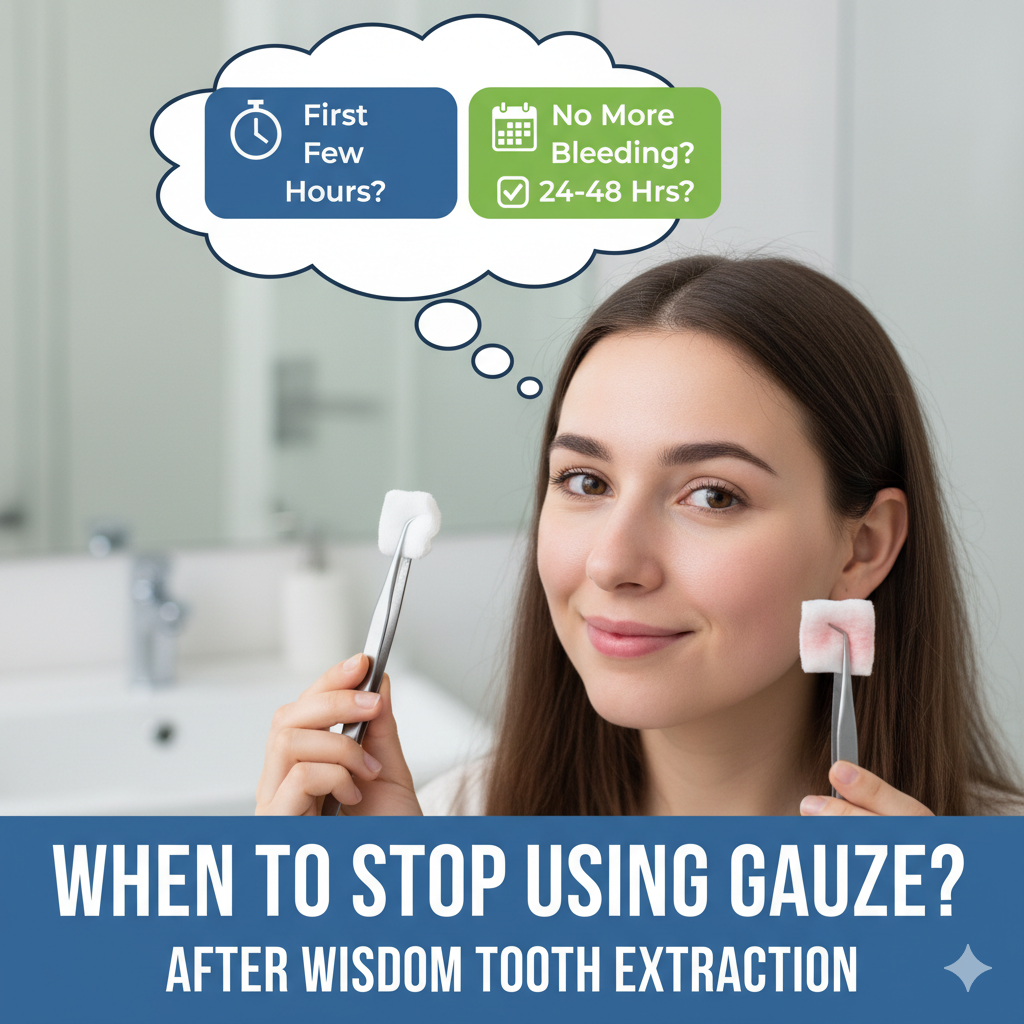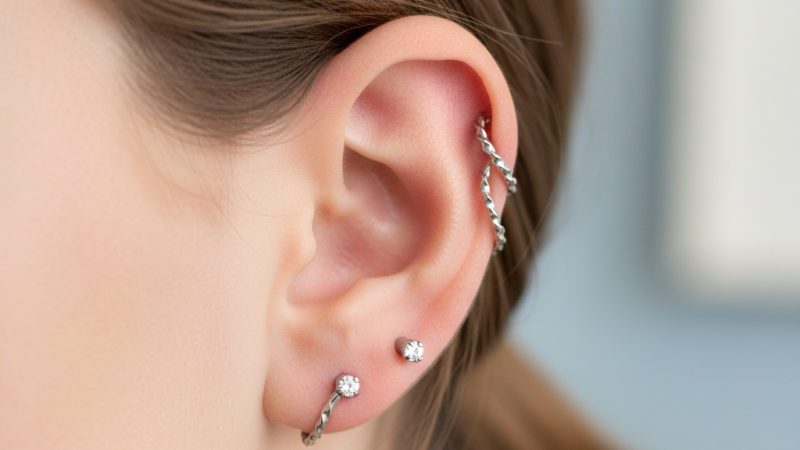When to Stop Using Gauze After Wisdom Tooth Extraction
Wisdom tooth extraction is one of the most common oral surgeries worldwide. Whether performed for impacted teeth, infection control, or pain management, it involves careful postoperative care. Among the most crucial parts of recovery is knowing when to stop using gauze after wisdom tooth extraction. While it may sound like a small detail, the correct timing ensures proper healing, minimizes the risk of complications like dry socket, and promotes healthy clot formation. Understanding the role of gauze, how long to use it, and when to stop can make your recovery much smoother and safer.

Understanding the Role of Gauze in Wisdom Tooth Extraction
After a wisdom tooth is removed, your dentist or oral surgeon places a sterile piece of gauze directly over the extraction site. This serves a vital purpose—it helps control bleeding and aids in clot formation. The blood clot is essential for healing, acting as a natural barrier that protects the exposed bone and nerve endings underneath. Without it, you could experience significant pain, delayed healing, and even infections.
Gauze works by applying gentle pressure to the wound. The absorbent material helps soak up excess blood while promoting the body’s natural clotting response. However, using gauze for too long can also have drawbacks—it may disturb the clot or create unnecessary pressure on the wound. Therefore, understanding when to stop using gauze after wisdom tooth extraction is critical for a healthy recovery.
How Long Should You Keep Gauze After Tooth Extraction?
In most cases, you should keep the initial gauze pad in place for about 30 to 45 minutes after the extraction. This gives the blood time to clot properly. Once you remove the first piece, check if the bleeding has slowed down. If the site is still actively bleeding, you can replace it with a new piece of clean, damp gauze and bite down gently for another 30 minutes.
Generally, bleeding should slow significantly within 2 to 3 hours post-surgery. Some minor oozing or pinkish saliva can continue for up to 24 hours, which is normal. However, if you find yourself changing gauze frequently after several hours, consult your dentist—it may indicate a clotting problem or excessive trauma to the wound. The key takeaway is that gauze should not be used indefinitely. It’s a temporary aid, not a long-term solution.
The Science Behind Blood Clot Formation
When a tooth is extracted, the body immediately begins a natural healing process. Blood flows into the empty socket, and platelets start forming a clot to seal the wound. This clot becomes the foundation for new tissue growth and bone healing. Disturbing it too early—by overusing gauze, spitting, or rinsing—can lead to complications like dry socket (alveolar osteitis).
Knowing when to stop using gauze after wisdom tooth extraction is directly tied to this clotting mechanism. Once the bleeding subsides and a stable clot has formed, continuing to bite down on gauze can dislodge it. Instead, focus on keeping the area clean, avoid suction movements (like using straws), and follow your dentist’s post-operative care instructions.
Signs It’s Time to Stop Using Gauze
Recognizing the right moment to stop using gauze is crucial. You should remove and discard the gauze when:
-
The bleeding has stopped, and only light oozing remains.
-
The gauze comes out mostly clean or slightly pink instead of soaked with blood.
-
There’s no metallic taste or consistent flow of blood in your mouth.
-
It’s been about two hours since extraction with minimal fresh bleeding.
After these signs appear, it’s time to remove the gauze permanently. Continuing to use it after clot formation can irritate the site, cause the clot to detach, or slow down healing.
What Happens If You Stop Too Early?
Stopping too early can be just as problematic as using gauze for too long. If you remove the gauze before a stable clot forms, the socket may begin bleeding again. This can lead to an unstable healing environment, where each clot attempt gets disturbed repeatedly. The result? A higher chance of infection and delayed recovery.
If bleeding resumes after you’ve stopped using gauze, don’t panic. Reapply a clean piece of damp gauze and maintain gentle pressure for another 30 minutes. You can also use a moistened tea bag—the tannic acid in tea promotes faster clotting. If bleeding persists beyond 24 hours, seek professional care immediately.
Common Mistakes People Make After Extraction
Many patients unintentionally prolong their recovery by making simple mistakes. Here are some of the most common:
-
Constantly changing gauze every few minutes. This disturbs clot formation.
-
Using dry gauze, which can stick to the wound and pull out the clot.
-
Sleeping with gauze in the mouth, increasing choking risks.
-
Spitting or rinsing vigorously soon after extraction.
-
Sucking motions like drinking through a straw, which create suction and dislodge clots.
Each of these mistakes can disrupt the healing process. Always follow your dentist’s advice regarding when to stop using gauze after wisdom tooth extraction and proper aftercare routines.
How Regional Practices Affect Post-Extraction Care
Interestingly, post-extraction care varies slightly depending on regional medical practices. In some regions, dentists recommend slightly longer gauze use due to climate or dietary habits that may affect healing. For instance, in humid regions, where the risk of bacterial infection is higher, maintaining a dry, protected socket is emphasized. Conversely, in colder or drier climates, excessive gauze use can dry out the tissue, slowing recovery.
The policy framework for dental and oral care across different countries also affects postoperative instructions. Some nations, especially those with robust public health programs, provide detailed dental hygiene education that includes guidance on when to stop using gauze after wisdom tooth extraction and how to manage oral wounds safely at home.
The Healing Timeline After Wisdom Tooth Extraction
-
First 24 hours – Bleeding control and clot formation.
-
Days 2–3 – Mild swelling and tenderness; avoid disturbing the clot.
-
Days 4–7 – Tissue begins repairing; pain and inflammation decrease.
-
Week 2 onwards – Gums close up, and bone remodeling begins.
During the first phase, gauze plays an essential role. But after 2–3 hours, your focus should shift toward maintaining the clot rather than managing bleeding. Beyond that, rest, proper hydration, and a soft diet will promote steady recovery.
Comparison With Other Dental Procedures
Unlike minor tooth extractions or cavity fillings, wisdom tooth removal often involves deeper tissue disruption. That’s why bleeding may last slightly longer. However, with proper gauze use and timing, recovery can be just as smooth. In root canal treatments, for example, there’s no open wound—so gauze isn’t needed at all. But after a surgical extraction, particularly of impacted wisdom teeth, the gauze acts as the first line of defense against infection and excessive bleeding.
Understanding when to stop using gauze after wisdom tooth extraction ensures that the same surgical precision applied in the dental chair continues through recovery at home.
Practical Tips for Safe Recovery
-
Always use clean, damp gauze, never dry.
-
Replace gauze gently—avoid forceful pressure.
-
Once bleeding stops, remove gauze completely to allow air circulation.
-
Maintain oral hygiene using mild saline rinses after 24 hours.
-
Avoid alcohol, smoking, and caffeine during early recovery.
Each of these steps supports natural healing and helps maintain the delicate blood clot, reducing the chance of complications like infection or dry socket.
The Role of Nutrition in Post-Extraction Healing
Diet plays a major role in your healing process. For the first few days, stick to soft, nutrient-rich foods like soups, smoothies, mashed vegetables, and yogurt. Avoid hot, spicy, or crunchy foods that might disturb the clot or reopen the wound. Iron-rich foods and vitamin C help with clot stabilization and tissue regeneration. A balanced diet accelerates healing and ensures that you won’t need to depend on gauze for long.
How to Know if You’re Healing Properly
A healthy recovery involves steady improvement each day. Here’s what to watch for:
-
Decreasing pain and swelling
-
Gradual closure of the extraction site
-
No fresh bleeding or foul odor
-
No severe pain after the third day
If you experience severe pain that radiates to your ear, jaw, or temple—especially after removing the gauze—it might indicate dry socket. Contact your dentist immediately if that happens.
Success Stories: Smooth Recoveries with Proper Care
Many patients who understand when to stop using gauze after wisdom tooth extraction experience nearly painless recoveries. Dental clinics report that those who follow gauze instructions closely tend to heal faster, experience fewer infections, and require fewer follow-up visits. Patients who maintain oral hygiene, proper nutrition, and avoid disturbing the clot often resume normal activities within a week. These success stories underline the importance of following professional guidance during your post-surgery period.
Challenges and Misconceptions
Despite clear instructions, misconceptions persist. Some believe that keeping gauze longer ensures better healing, while others think removing it too soon will cause bleeding. Both are myths. The truth lies in balance—gauze is only a temporary bleeding aid. Overuse can suffocate the wound, slow tissue oxygenation, and increase infection risk.
Another challenge is misinformation on social media. Many “home remedy” videos suggest random timeframes for gauze removal without understanding individual healing differences. Always rely on medical advice tailored to your own extraction procedure.
The Dentist’s Perspective: Why Timing Matters
From a clinical point of view, timing the removal of gauze is essential. The average dentist expects the clot to form within the first 30 to 45 minutes. If it doesn’t, extended gauze use may be advised, but usually not beyond two hours. Dentists emphasize that gauze use should stop as soon as bleeding subsides, not based on the clock. The reason is simple—each patient’s clotting ability varies depending on age, medications, and health conditions.
This explains why dentists provide personalized instructions and sometimes recommend alternative materials like hemostatic sponges or collagen pads for patients with slow clotting tendencies.
The Broader Health Context
Proper oral care after surgery reflects broader principles of public health and social welfare initiatives. Many countries run oral health awareness campaigns to educate people about postoperative hygiene. These efforts—similar to women empowerment schemes and rural development initiatives in other health sectors—aim to reduce infection rates, minimize postoperative complications, and promote community well-being.
The understanding of when to stop using gauze after wisdom tooth extraction might seem minor but, in a public health context, it’s a crucial element of preventive care, ensuring that minor surgeries don’t lead to major infections.
Comparing Recovery Patterns: Urban vs. Rural Populations
Access to dental care affects how patients recover from wisdom tooth surgery. In urban areas, people often receive detailed postoperative guidance and sterile supplies. In contrast, rural populations might rely on traditional remedies, which can delay healing. Education and awareness programs play a vital role here—especially those focusing on safe wound management, sterile gauze use, and recognizing warning signs of infection.
These community-based programs mirror broader rural development efforts, highlighting how oral health awareness contributes to overall social welfare.
Technological Advances in Post-Extraction Care
Modern dentistry has evolved significantly. Surgeons now use absorbable dressings, laser-assisted healing, and biocompatible materials that minimize the need for prolonged gauze use. With these innovations, the average healing time has shortened, and the risk of complications reduced drastically.
However, despite technology, one principle remains unchanged: understanding when to stop using gauze after wisdom tooth extraction continues to be a cornerstone of recovery. Even the most advanced surgical methods rely on the body’s natural healing process, which begins with a stable blood clot.
Long-Term Oral Health After Extraction
After your recovery, maintaining long-term oral hygiene becomes crucial. Once the gums have healed, brush and floss carefully around the area to prevent plaque buildup. Regular dental checkups ensure that no infection develops in the socket. Patients who follow post-extraction guidelines tend to have better overall oral health outcomes.
Proper early care—including correct gauze timing—also reduces the likelihood of chronic issues like bone exposure or prolonged tenderness.
Future Prospects: Smarter Healing Solutions
In the coming years, we may see the rise of smart gauze materials embedded with antibacterial agents and clot sensors that notify patients when to remove them. Researchers are already exploring biopolymers that adapt to saliva pH and dissolve naturally once clotting completes. These innovations will revolutionize oral surgery recovery and make instructions like “when to stop using gauze after wisdom tooth extraction” even more precise and patient-friendly.
Summary
Gauze plays a vital but short-lived role in the healing process after wisdom tooth removal. It helps stop bleeding and aids in clot formation—but should not be overused. Most people can safely stop using gauze within 2 hours after extraction, once bleeding slows and a stable clot forms. Overuse can cause complications, while premature removal may restart bleeding. The best approach is to follow your dentist’s advice, maintain oral hygiene, and let your body’s natural healing process take over.
Knowing when to stop using gauze after wisdom tooth extraction is not just about time—it’s about observing your body’s signals and responding wisely. With proper care, most patients heal comfortably within a week and return to normal routines without issues.
FAQs
1. How long should I use gauze after wisdom tooth extraction?
You should keep gauze in place for about 30–45 minutes after the procedure and replace it if bleeding continues. Most patients can stop using gauze within 2 hours.






